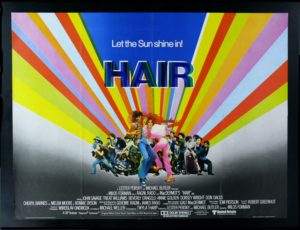 Anyone who knows me knows that I’m a bit of a fan of the classic American Musical. That cuts off around the mid-60s, a little after West Side Story. Anything after that I likely haven’t had a lot of exposure to (which is one of the oversights I’m trying to fix lately).
Anyone who knows me knows that I’m a bit of a fan of the classic American Musical. That cuts off around the mid-60s, a little after West Side Story. Anything after that I likely haven’t had a lot of exposure to (which is one of the oversights I’m trying to fix lately).
The stage version of Hair came out in 1968. That whole Vietnam War thing was a big deal then. The counter-culture movement was in full-swing and Woodstock was still about a year out on the horizon. People knew things were changing, that there was a groundswell of new(ish) ideas rolling through the youth culture. The play grabbed all of that energy and ran with it. The play was a big hit.
More than ten years later, in 1979, Hair the movie came out. The “peace, love, and music” of the 60s had become the “sex, drugs, and rock n’ roll” of the 70s. Idealism was a bit on the wane as the economy went through a rough patch or three. That Vietnam War thing was something people really, really didn’t like to talk about, as it hadn’t gone all that well for us, politically or domestically. The film jettisoned a bunch of what the play had and ran with the new zeitgeist a bit… pretty much using most of the same music and character names, but coming up with a mostly new plot. The difference was so great that the writers of the play still don’t feel that it’s ever actually been adapted into a movie. The movie was a big hit.
The Plot
Claude is a good boy from Oklahoma who’s on his way to NY to enlist in the Army. He gets there a couple of days early in order to see some sights in the big city before he ships off to basic training. While wandering through Central Park, he encounters Berger, Jeannie, Hud, and Woof, four hippies just doing their thing, sewing some seeds of chaos/enlightenment here and there. Shelia, a well-to-do high-class, horse-riding girl also catches the attention–of both Claude and Berger–much to the displeasure of Sheila’s mother and aunt who are riding with her through the park.
So begins a kind of wild couple of days of adventure filled with drugs, law breaking, and more new ideas than Claude can really take in. Eventually, he does make it to the recruitment office and off to basic training in Nevada, but then there’s just one more adventure that has some very unexpected consequences.
The Music
Chances are, right now, you know more about the plot of this movie than you ever have before. I know I went into it pretty much completely blind. I knew it existed. I knew it was an adaptation of a play. But, in all the years of hearing about it, never once had anyone talked about the plot.
What they talked about–and what you couldn’t avoid if you were listening to the radio in my house growing up–was the music.
The music is very distinctly “the 60s” (specifically the late, psychedelically-tinged, 60s). You’ve probably heard some of the music, even if you didn’t know it came from Hair. It gets used a lot.
There’s “Age of Aquarius” (which is the opening tune for the movie)…
There’s “Good Morning Starshine” (sung in the movie by Beverly D’Angelo, who played Sheila)…
Of course there’s “Hair” (which has a bit more meaning once you see the context in the movie)…
That last one didn’t get a lot of radio play, but it got referenced a lot in other places.
The thing is, these are far from the best songs in the show. The best songs are a bit more edgy… downright damning of the mainstream culture and the things it turns a blind eye toward. And they don’t play quite as well outside of the context of the story.
There’s “Black Boys/White Boys” which deals with the fetishization of race and the sterotypes that go along with it.
There’s “Three Five Zero Zero” which is distinctly an anti-war song…
For some reason, “Sodomy” never got any radio play…
I could go on, because pretty much every song in this film is solid and meaningful. Even the stuff that tends more toward fluff (like “Sodomy”) pushes the comfort zone of the audience just a little bit.
That idea of getting outside of your comfort zone is really a key thing in Hair. It’s what propels Claude into the adventures he has with Berger and crew, it’s what differentiates Sheila from the rest of her family, it what, in the real world, has ultimately lead to a whole lot of positive changes.
If nothing else, check out this film for the music.
The Verdict
Without having ever seen the stage version, I absolutely love this film. The antics in the plot aren’t the most coherent things in the world, but that’s kind of the style of the times in a lot that came out of the 60s. It’s uncomfortable, but you run with it, because you choose to. Because choosing to embrace the insanity is the only way you can exert any real control. Because doing otherwise robs you of your sense of self.
And if there’s one thing this film makes really clear is that, when you get right down to it, authenticity of self is what will both save and destroy you. But if it destroys you, at least you’ll be saving someone else in the process.
The bonds of friendship among Claude, Berger, Sheila and everyone else in the counter-culture group are vivid and lively. The bonds of obligation and tradition shown in pretty much everyone else they deal with are bland and, in the context of the film, a fate worse than death.
Never once, though, do the hippies tell anyone that they can’t live their lives in a walking death. They say it’s not for them, they point out the folly of it, they poke fun at it… but when all is said and done Berger and friends never actually tell anyone they have to change. The mainstream culture, on the other hand… well, every time someone opens their mouth it’s not out of love or concern, it’s a quest to remove that which makes them uncomfortable.
I like movies with messages like that.
Maybe you do, too.
If you do, definitely check this out. If you’re a fan of musicals in general, and the 60s in particular, you absolutely need to see this.

Leave a Reply